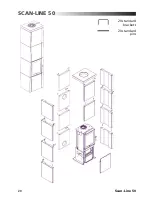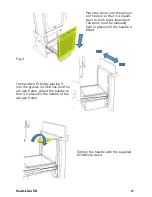
6
Stove data table in accordance with EN 13240 testing.
Stove
type
Scan-Line
series
Nominal
fluegas
tempera-
ture c°
Smoke
stub
mm
Fuel
volume
kg
Draught
min
mbar
Nominal
output
tested
kW
Heat
output
kW
Distance to flammable
materials in mm
behind at the
the stove sides
Distance to
furnitures from
the stove in
mm
Stove
weight
kg
40
257
ø150
1.6
0.12
5
5
150 400
900
420
50
257
ø150
1.6
0.12
5
5
150 400
900
541
The nominal output is the output to which the stove has been tested.
The test was carried out with the secondary air 70% open.
The chimney must be swept at least
once a year, we recommend the use
of a NACS (national association of
chimney sweeps) registered chim-
ney sweep. In the event of smoke or
malodorous fumes being produced,
you must first check to see whether
the chimney is blocked. The chimney
must, of course, always provide the
minimum draught necessary to ensure
that it is possible to regulate the fire.
Please note, however, that chimney
draft is dependent on the weather
conditions. In high winds, the draft
can become so powerful that it may
be necessary to fit a damper in the
The surface of the stove has been trea-
ted with heat-resistant paint.
The stove should be cleaned with a
damp cloth. Any damage to the sur-
face in the form of chips or scratches
can be repaired using touch-up paint,
which is available in spray cans.
Cleaning the glass
Incorrect firing, for example using
wet wood, can result in the viewing
window becoming covered in soot.
This soot can be easily and effectively
removed by using proprietary stove
glass cleaner.
flue gas pipe to regulate the draft.
When cleaning the chimney, soot and
other deposits may come to fall on the
smoke plate.
In cases where the wood
burns too quickly, this may be due
to excessive chimney draught. You
should also check to make sure that
the door seal and ashpan seal is intact
and correctly fitting.
If the stove it generating too little
heat, this may be because you are fi-
ring with wet wood. In this case, much
of the heating energy is used to dry
the wood, resulting in poor heating
economics and an increased risk of
soot deposits in the chimney.
OPERATIONAL PROBLEMS
MAINTENANCE
Summary of Contents for SCAN-LINE 40
Page 1: ...1 www heta dk SCAN LINE 40 SCAN LINE 50 OPERATING INSTRUCTIONS GB www heta dk ...
Page 10: ...10 16 x standard brackets 12 x standard pins SCAN LINE 40 Scan Line 40 ...
Page 13: ...13 Scan Line 40 ...
Page 14: ...14 Scan Line 40 ...
Page 15: ...15 Scan Line 40 ...
Page 20: ...20 SCAN LINE 50 20 standard brackets 20 standard pins Scan Line 50 ...
Page 23: ...23 Scan Line 50 ...
Page 24: ...24 Scan Line 50 ...
Page 25: ...25 Scan Line 50 ...
Page 31: ...31 ...
Page 32: ...32 17 11 2015 0037 1445 ...







































